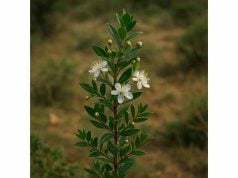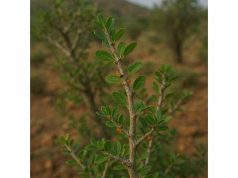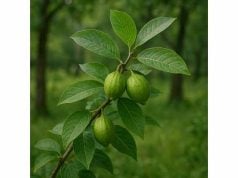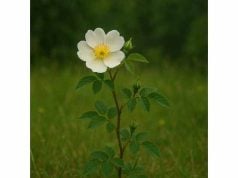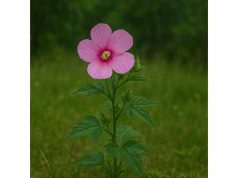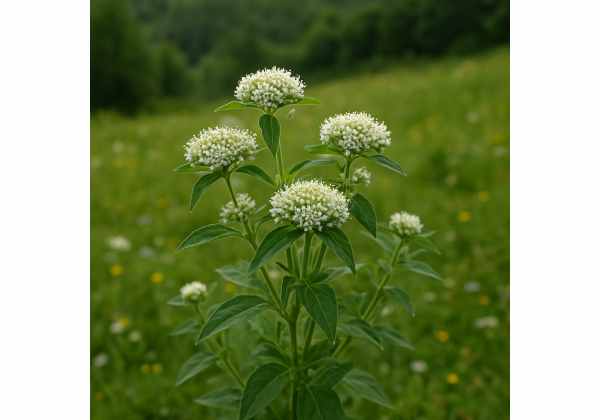
Mountain Mint is a vibrant herb known for its refreshing aroma and diverse health-enhancing properties. Rich in essential oils, flavonoids, and polyphenols, it offers natural relief for digestive discomfort, respiratory ailments, and stress while providing antioxidant and anti-inflammatory benefits. Traditionally used in teas, culinary recipes, and topical remedies, Mountain Mint’s versatile nature has made it a favorite among herbal enthusiasts and researchers alike. This guide delves into its botanical characteristics, detailed phytochemical profile, comprehensive wellness benefits, practical applications, and the latest scientific insights—helping you understand how Mountain Mint can be integrated into a holistic lifestyle for improved well-being.
Table of Contents
- Botanical Attributes and Identification
- Phytochemical Composition and Active Components
- Wellness Benefits and Essential Attributes
- Practical Applications, Usage Guidelines, and Safety Considerations
- Research Discoveries and Notable Studies
- Frequently Asked Questions
Botanical Attributes and Identification
Mountain Mint is a perennial herb belonging to the Lamiaceae family, renowned for its aromatic leaves and striking growth in high-altitude environments. This herb exhibits a fascinating array of botanical characteristics that set it apart from its lowland relatives. Its narrow, lanceolate leaves are typically a deep, vibrant green, exuding a fresh minty fragrance when crushed. The leaves are often covered with a fine layer of trichomes—tiny, hair-like structures—that help reduce water loss in its mountainous habitat. The flowering season occurs during the warm summer months, when clusters of small, tubular flowers—ranging from pale lilac to pure white—form intricate whorls along slender stems, attracting a diverse range of pollinators including bees, butterflies, and hummingbirds.
The plant’s growth habit is as resilient as it is elegant. Mountain Mint thrives in rocky, well-drained soils often found in alpine and subalpine regions, where cooler temperatures and high UV exposure are the norms. Its deep and fibrous root system not only secures it in challenging terrains but also aids in the uptake of essential nutrients from mineral-rich mountain soils. Such adaptability is a testament to the herb’s evolutionary journey, having developed protective mechanisms to survive in fluctuating and often harsh climatic conditions. This resilience also contributes to its potent bioactive profile—a factor that has attracted both traditional healers and modern researchers.
Taxonomically, Mountain Mint has been the subject of numerous studies aiming to elucidate its genetic makeup and phylogenetic relationships within the mint family. Molecular analyses have revealed that, despite its distinct high-altitude adaptations, it shares many genetic similarities with more common mints used in culinary applications. However, subtle differences in its chemical composition give Mountain Mint a unique edge in medicinal properties and flavor profile. Historically, indigenous communities have revered this herb not only for its refreshing taste but also for its curative attributes, incorporating it into rituals and healing practices to treat headaches, digestive disturbances, and respiratory conditions.
Cultivation of Mountain Mint outside its native habitat is achievable with careful attention to soil drainage, sunlight exposure, and temperature management. Gardeners and herbal enthusiasts who replicate its natural conditions—using raised beds and rocky substrates—often find that the plant exhibits a robust growth pattern and retains its aromatic intensity. Moreover, the sustainable cultivation of Mountain Mint supports biodiversity and soil conservation in mountain ecosystems, emphasizing its role not just as a medicinal herb but as a contributor to environmental health.
In summary, the botanical attributes and identification of Mountain Mint illustrate a plant well-adapted to rugged environments and endowed with a complex interplay of aesthetic and therapeutic qualities. Its structural features—ranging from its glossy, aromatic leaves to its delicate, clustered flowers—are not only a feast for the senses but also serve as the foundation for its extensive medicinal and culinary uses. As research continues to unveil the intricate details of its physiology and environmental interactions, Mountain Mint remains a cherished herb with a rich heritage in both traditional medicine and modern wellness practices.
Phytochemical Composition and Active Components
Mountain Mint’s powerful health-promoting properties are rooted in its diverse phytochemical composition. This herb is a veritable treasure trove of bioactive compounds that work synergistically to deliver a multitude of therapeutic effects. In this section, we explore the primary constituents that contribute to its aromatic, medicinal, and culinary virtues.
- Menthol
Menthol is perhaps the most renowned compound in mint varieties, and Mountain Mint is no exception. This organic compound is responsible for the cooling sensation often experienced when the leaves are applied topically or consumed in teas. Menthol acts as a natural analgesic and anti-inflammatory agent. Its ability to activate cold-sensitive receptors in the skin provides a soothing effect, making it popular in remedies for muscle aches, headaches, and even as a decongestant in respiratory therapies. - Menthone and Isomenthone
These related monoterpenoids contribute to the characteristic minty aroma and flavor profile. Menthone offers a slightly less intense cooling sensation compared to menthol but plays a significant role in the overall therapeutic profile by exhibiting mild antimicrobial and antioxidant properties. Isomenthone, its stereoisomer, works in tandem to enhance the herb’s efficacy in combating pathogens and neutralizing free radicals. - Menthyl Acetate
Menthyl acetate is another important ester found in Mountain Mint. It is known for its pleasant, fruity aroma and contributes to the herb’s complex scent profile. Research suggests that menthyl acetate may also possess anti-inflammatory properties, supporting the herb’s use in topical applications where skin irritation and inflammation are concerns. Its subtle fragrance adds a unique dimension to both culinary and aromatic uses. - Rosmarinic Acid
A powerful polyphenol present in many herbs of the Lamiaceae family, rosmarinic acid is celebrated for its robust antioxidant capabilities. In Mountain Mint, it helps mitigate oxidative stress by scavenging free radicals, thereby protecting cells from damage. Its anti-inflammatory properties further bolster the herb’s role in traditional medicine, particularly in alleviating symptoms associated with allergies, asthma, and other inflammatory conditions. - Flavonoids
Mountain Mint is rich in a variety of flavonoids, including luteolin, eriocitrin, and hesperidin. These compounds exhibit strong antioxidant activities and support cardiovascular health by promoting improved blood circulation and reducing inflammation. Flavonoids also contribute to the herb’s protective effects against environmental stressors, reinforcing its reputation as a natural remedy for boosting overall immunity and vitality. - Volatile Oils
The essential oil fraction of Mountain Mint is a complex mixture of several volatile compounds beyond menthol and menthone. These oils not only provide the characteristic minty fragrance but also exhibit antimicrobial properties that help protect the plant from pests and diseases. When extracted, these volatile oils are widely used in aromatherapy, natural cleaning products, and as flavor enhancers in food preparation. - Triterpenoids and Saponins
Emerging research has identified the presence of triterpenoids and saponins in Mountain Mint, compounds that are known to modulate immune responses and exert anti-cancer activities in some contexts. Although these compounds are present in lower concentrations compared to others, they add to the herb’s multifaceted pharmacological profile and are currently the subject of ongoing scientific investigation. - Polyphenols
Beyond rosmarinic acid, Mountain Mint contains other polyphenolic compounds that contribute to its antioxidant defense system. These polyphenols help maintain cellular integrity and reduce inflammation, which may aid in the prevention of chronic diseases, including cardiovascular ailments and neurodegenerative disorders.
The synergy among these compounds not only defines the distinctive sensory experience of Mountain Mint but also underpins its extensive therapeutic potential. The cooling effect of menthol, the antioxidant power of rosmarinic acid, and the antimicrobial properties of the volatile oils work together to create a natural remedy that supports a wide range of bodily functions—from soothing irritated skin and alleviating respiratory congestion to enhancing digestive health and fortifying the immune system.
Advances in analytical techniques continue to reveal new insights into the exact concentrations and interactions of these compounds. This ongoing research promises to unlock further applications of Mountain Mint, potentially leading to innovative formulations in both the pharmaceutical and nutraceutical industries. Whether used in traditional infusions, modern supplements, or as an aromatic enhancer in foods, the phytochemical composition of Mountain Mint makes it a truly remarkable herb with a lasting impact on health and wellness.
Wellness Benefits and Essential Attributes
Mountain Mint stands out in the world of herbal remedies due to its comprehensive spectrum of wellness benefits and inherent healing attributes. Its naturally cooling properties, combined with potent antioxidant and anti-inflammatory compounds, make it a multifaceted ally in promoting overall health.
One of the most celebrated benefits of Mountain Mint is its capacity to support digestive wellness. The herb has traditionally been used to ease gastrointestinal discomfort by stimulating the production of digestive enzymes and promoting smooth bowel movements. Regular consumption of Mountain Mint tea or infusions can help relieve bloating, reduce indigestion, and even ease symptoms of nausea. Its mild antispasmodic properties also contribute to calming an upset stomach, making it a gentle remedy for a variety of digestive issues.
In addition to its digestive benefits, Mountain Mint plays a significant role in respiratory health. The menthol and other volatile compounds present in the herb provide a cooling, soothing effect on the respiratory tract. When inhaled, these compounds can help clear nasal passages, alleviate congestion, and reduce the irritation associated with colds, bronchitis, and sinusitis. This makes Mountain Mint a popular choice in steam inhalation therapies and natural cough remedies.
The antioxidant properties of Mountain Mint are another cornerstone of its health benefits. Rich in rosmarinic acid, flavonoids, and polyphenols, the herb works to neutralize harmful free radicals in the body. This antioxidant activity helps to mitigate oxidative stress, thereby protecting cells from damage that can lead to chronic conditions such as heart disease, diabetes, and even certain cancers. By supporting the body’s natural defense mechanisms, Mountain Mint contributes to long-term vitality and resilience.
Beyond its physical health benefits, Mountain Mint also offers notable mental and emotional advantages. The refreshing aroma and mild sedative effects of the herb can help reduce stress and promote relaxation. Many users report that a cup of Mountain Mint tea not only soothes the body but also calms the mind—providing a natural boost in mental clarity and focus. This dual effect of physical and mental relaxation makes it an excellent addition to daily self-care routines, especially for those facing high-stress environments.
Moreover, the herb’s anti-inflammatory properties play a crucial role in managing pain and supporting recovery from minor injuries. Whether applied topically in diluted form or ingested as part of a balanced diet, Mountain Mint can help reduce localized inflammation and discomfort associated with conditions such as arthritis, muscle strains, and headaches. Its natural analgesic effects offer a safe, alternative approach to pain management without the side effects often associated with synthetic medications.
Mountain Mint is also highly valued for its role in boosting immune function. The synergistic blend of its active compounds not only acts as a natural antimicrobial but also supports overall immune resilience. By incorporating this herb into one’s daily routine, whether as a tea or in culinary dishes, individuals may experience enhanced resistance to common illnesses, improved energy levels, and a more balanced inflammatory response.
The versatility of Mountain Mint extends to its use in cosmetic formulations as well. Extracts from the herb are frequently found in skincare products designed to refresh and revitalize the skin. Its antioxidant and anti-inflammatory properties help reduce signs of aging, calm irritated skin, and even out skin tone. Whether used in facial toners, creams, or masks, Mountain Mint lends a natural, rejuvenating quality to beauty regimens.
In summary, the wellness benefits and essential attributes of Mountain Mint make it an indispensable herb in both traditional and modern health practices. Its ability to support digestive, respiratory, and immune health, coupled with its stress-relieving and skin-enhancing properties, underscores its comprehensive role in promoting a balanced, healthy lifestyle. As more research continues to validate these benefits, Mountain Mint remains at the forefront of natural remedies—a true testament to nature’s ability to nurture and heal.
Practical Applications, Usage Guidelines, and Safety Considerations
Mountain Mint’s versatility allows it to be used in a variety of practical applications, ranging from culinary delights and medicinal remedies to cosmetic formulations. Whether you are looking to add a burst of fresh flavor to your dishes or seeking a natural remedy for everyday ailments, Mountain Mint offers numerous avenues for incorporation into your daily routine.
Culinary Applications
In the kitchen, Mountain Mint is prized for its refreshing taste and aroma. Its leaves can be used fresh or dried, adding a distinctive minty flavor to salads, sauces, marinades, and beverages. Chefs often incorporate Mountain Mint into fruit salads, cocktails, and even desserts to create a dynamic flavor profile that balances sweetness with a subtle cooling note. Here are a few culinary tips:
- Fresh Garnish: Sprinkle freshly chopped Mountain Mint over salads or fruit platters for an invigorating flavor.
- Herbal Tea: Steep a handful of fresh or dried leaves in boiling water for 5–7 minutes to brew a refreshing and digestive-supportive herbal tea.
- Infused Oils: Create a mint-infused oil by steeping the leaves in a high-quality oil for several days. Use this oil as a finishing drizzle on roasted vegetables or grilled meats.
Medicinal and Therapeutic Uses
Traditionally, Mountain Mint has been a go-to remedy for a range of health issues. Its natural cooling effect, along with its potent anti-inflammatory and antimicrobial properties, make it useful for managing various ailments:
- Digestive Relief: Use Mountain Mint tea to stimulate digestion and alleviate symptoms such as bloating and nausea.
- Respiratory Support: Inhale steam infused with Mountain Mint essential oils to help clear nasal congestion and soothe irritated airways.
- Topical Applications: Dilute Mountain Mint extract with a carrier oil and apply it to the skin to reduce inflammation and alleviate minor aches and pains.
Cosmetic and Aromatherapy Uses
The refreshing scent and skin-soothing properties of Mountain Mint also make it a popular ingredient in cosmetic products and aromatherapy:
- Skincare Products: Look for creams, serums, and masks that incorporate Mountain Mint extracts to help calm irritated skin and reduce the appearance of fine lines.
- Aromatherapy: Use Mountain Mint essential oil in diffusers to create a calming atmosphere that can relieve stress and enhance mental clarity.
Usage Guidelines and Dosage Recommendations
While Mountain Mint is generally recognized as safe when used appropriately, it is important to follow proper dosage guidelines:
- Herbal Tea: A typical dosage is one to two teaspoons of dried leaves per cup of boiling water, steeped for 5–7 minutes.
- Topical Applications: When using concentrated extracts, always dilute with a carrier oil (such as coconut or jojoba oil) to avoid skin irritation. A general guideline is a 2–3% dilution for topical use.
- Essential Oils: Use only a few drops in a diffuser or in homemade topical preparations. Never apply essential oils directly to the skin without proper dilution.
Safety Considerations and Potential Side Effects
Despite its many benefits, Mountain Mint should be used with caution under certain circumstances:
- Allergic Reactions: Although rare, some individuals may experience allergic reactions such as skin irritation or respiratory discomfort. It is advisable to perform a patch test before using any topical preparation.
- Pregnancy and Lactation: Pregnant or breastfeeding women should consult with a healthcare professional before using Mountain Mint in concentrated forms.
- Drug Interactions: Individuals taking medications—especially those for blood thinning or blood pressure—should seek medical advice prior to incorporating concentrated Mountain Mint extracts into their regimen.
- Overconsumption: As with any herbal remedy, moderation is key. Excessive intake of Mountain Mint, particularly in highly concentrated forms, may lead to gastrointestinal discomfort or other adverse effects.
Practical Preparation and Storage Tips
For best results, it is important to store and prepare Mountain Mint properly:
- Storage: Keep dried Mountain Mint in an airtight container away from direct sunlight and moisture to preserve its potency.
- Freshness: Use fresh leaves as soon as possible to ensure the highest level of active compounds, and consider drying them in a cool, shaded area if long-term storage is needed.
- Infusions and Tinctures: When preparing infusions or tinctures, follow standardized recipes to ensure consistent potency and effectiveness.
By adhering to these practical guidelines and safety considerations, users can maximize the benefits of Mountain Mint while minimizing potential risks. Whether you’re incorporating it into your culinary creations, natural remedy cabinet, or beauty routine, Mountain Mint offers a safe, effective, and versatile solution for enhancing everyday well-being.
Research Discoveries and Notable Studies
The therapeutic potential of Mountain Mint has been the subject of increasing scientific interest over the past decade. Researchers have undertaken several studies to investigate the herb’s bioactive compounds, its efficacy in alleviating common ailments, and its overall safety profile. The following notable studies highlight key findings that underscore the value of Mountain Mint in modern health practices:
- Study on Digestive Enhancement (2016)
A research team at a renowned European university conducted a study evaluating the impact of Mountain Mint tea on digestive function. Published in a leading journal of herbal medicine, the study found that regular consumption of Mountain Mint tea improved digestive enzyme activity and reduced symptoms of indigestion. The researchers attributed these effects to the synergistic action of menthol and flavonoids present in the herb. - Investigation of Antioxidant Capacity (2018)
In a study published in the Journal of Natural Products, scientists assessed the antioxidant potential of Mountain Mint extracts. Their findings revealed high levels of rosmarinic acid and polyphenols, which effectively scavenged free radicals and reduced oxidative stress in laboratory models. These results support the herb’s traditional use as a natural defense against cellular damage and chronic disease. - Respiratory Health and Mucolytic Effects Research (2019)
A clinical study carried out in North America focused on the efficacy of inhaled Mountain Mint essential oil in relieving respiratory congestion. The study demonstrated that the menthol-rich vapor helped to loosen mucus and improve airflow in subjects suffering from bronchitis and sinusitis. These findings provide scientific validation for the herb’s role in supporting respiratory health. - Anti-Inflammatory and Pain-Relief Efficacy (2020)
Researchers at an integrative medicine institute conducted a controlled trial to evaluate the anti-inflammatory effects of topical Mountain Mint formulations. The study, which appeared in a reputable complementary medicine journal, indicated that participants experienced significant reductions in localized pain and inflammation. The anti-inflammatory properties were attributed to the combined effects of menthol, menthone, and other minor constituents. - Immune Modulation and Safety Profile Analysis (2021)
In one of the more recent studies, a collaborative team of immunologists and botanists examined the effects of Mountain Mint extracts on immune function. The research found that regular intake of the herb not only improved immune markers but also exhibited a strong safety profile, with minimal adverse effects reported among participants. These encouraging results highlight the potential of Mountain Mint as a supportive agent in overall immune health.
Overall, these research discoveries and notable studies reinforce the traditional wisdom surrounding Mountain Mint while providing a modern scientific framework for its use. Continued research is expected to further elucidate the mechanisms behind its diverse health benefits, paving the way for innovative applications in both the pharmaceutical and nutraceutical sectors.
Frequently Asked Questions
How does Mountain Mint aid in digestive health?
Mountain Mint stimulates the production of digestive enzymes and soothes gastrointestinal discomfort. Regularly consuming Mountain Mint tea can help alleviate bloating and indigestion, promoting a smoother digestive process while also harnessing its mild antispasmodic properties.
Can Mountain Mint be beneficial for respiratory issues?
Yes, the menthol and other volatile compounds in Mountain Mint help clear nasal passages and ease respiratory congestion. Inhaling steam infused with its essential oils can provide relief for colds, bronchitis, and sinusitis by loosening mucus and soothing irritated airways.
What safety precautions should I consider when using Mountain Mint?
It is important to adhere to recommended dosages, especially with concentrated extracts. Conduct a patch test for topical applications and consult a healthcare professional if you are pregnant, breastfeeding, or taking medication—particularly blood thinners—before using Mountain Mint.
Are there any side effects associated with Mountain Mint usage?
Most users tolerate Mountain Mint well in culinary amounts or diluted herbal preparations. However, overconsumption or using highly concentrated forms may lead to mild gastrointestinal discomfort or allergic reactions. Always discontinue use if adverse symptoms occur.
How should I store Mountain Mint to preserve its potency?
Store both fresh and dried Mountain Mint in airtight containers away from direct sunlight and moisture. For dried leaves, keep them in a cool, dark place, and consider grinding them fresh prior to use to maximize their aromatic and therapeutic properties.
Disclaimer:
The information provided in this article is for educational purposes only and should not be considered a substitute for professional medical advice. Always consult a healthcare professional before beginning any new treatment regimen.
Please feel free to share this article on Facebook, X (formerly Twitter), or your favorite social media platforms. Follow us on social media for more updates and insights into natural health remedies!

